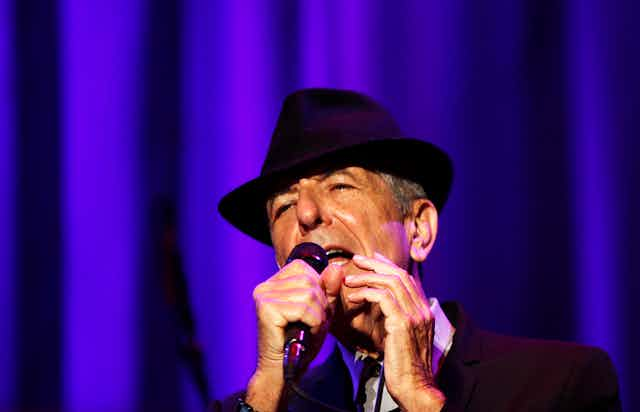The final few bars of Leonard Cohen’s life song have been played out. He was the elder statesman of a trio of iconic male North American singer-songwriters that included Bob Dylan and Tom Waits. This group of musical malcontents laid bare the American male psyche in a way that hadn’t been heard before. Their singing was the flip side to the American Dream, a jarring contrast to the seductively beautiful voices of Frank Sinatra and Elvis Presley, each using an idiosyncratic vocal tone to channel the anger, joy and pain of their songs.
Cohen’s voice seemed to sink into the depths as he got older and by the time he recorded Hallelujah in 1984 at the age of 50 it had morphed into a mournful “basso profundo”. Astonishingly, despite containing a song that has now inspired over 300 versions, Cohen’s American label declined to release the album Various Positions. This may account for the way the song has gradually seeped into the public consciousness. It was other artists’ takes on Cohen’s song, rather than the original, that built a wave of interest in it and made Hallelujah into the modern hymn it is today.
First out of the blocks was John Cale in 1991 with a piano and vocal version on the Cohen tribute album I’m Your Fan. It brought a more obvious passion to the song than Cohen’s more emotionally guarded reading. The recording was picked up to be used in the 2001 film Shrek, starting a long sequence of placements in movies and TV shows.
But the most critically acclaimed version was recorded in 1994 by the late American singer-songwriter Jeff Buckley on his album Grace. Opening with a complex solo guitar exploration of the song’s chords, Buckley brought a quasi-classical fragility to his performance that cemented his position as the romantic electric troubadour par excellence. The album is now regarded as a classic, with Buckley’s version of Hallelujah being ranked in the Rolling Stone Magazine’s 500 Greatest Songs Of All Time.
So what makes the song so powerful – and why has it reached out to so many people?
Its chords are simple, mostly coming from the notes of the major scale of the song’s key. Rhythmically it has the type of rolling 12/8 feel you find in much gospel and folk music – again nothing special. But this is where the songwriter’s craft comes in. In the greatest songs there is a combination of lyric, melody, rhythm and harmony that come together in an alchemic fusion of craft, inspiration and perspiration. Cohen is one of the great songwriters and wrote as many as 80 verses of Hallelujah before cutting it down to a final four.
That commitment to the craft is evident in the melodic construction, which is as organised as a Mozart melody or Miles Davis improvisation. The verse begins with a simple questioning melodic figure that moves stepwise in tones between the fifth and sixth degrees of the scale. It is the second half of the verse where the magic begins. Again the melody ascends from the fifth but this time keeps driving on up until it has climbed up a sixth to the major third. This passage is central to the song’s emotional core, driving the listener into a state of near ecstasy. Cohen combines the melodic journey with a knowing lyric that lays bare the song’s harmonic construction:
Well it goes like this:
The fourth, the fifth, the minor fall and the major lift
The baffled king composing Hallelujah
Managing the internal rhymes as well as getting the chords to match the lyric is a feat of songwriting on a par with Cole Porter, one of the greatest writers of The Great American Songbook era, who similarly marks a change “from major to minor” in the song “Every Time we Say Goodbye”. The chorus of Hallelujah is simpler, beginning with an ascending three note motif that then descends again, highlighting the fifth and sixth degrees of the scale. The use of these intervals may be a nod to Handel’s “Hallelujah Chorus” from the oratorio “The Messiah”, which also emphasises the same pitches.
But in addition to the nerdiness of my musicological deconstruction I wanted to try to understand the spirituality and religious references in the song. For this I turned to Felicity Buirski, a singer-songwriter, psychotherapist and close friend of Leonard Cohen. She explained:
Most singer songwriters don’t like their songs torn apart and mauled by the thinking brain when so much poetry is about articulating often frozen inarticulate feelings, and Leonard was no exception. He once told me that he didn’t have to explain away his songs when I pressed him on a certain lyric’s meaning.
As a songwriter myself I now know that the best poetry is often written just prior to understanding. To me Leonard’s exceptionally beautiful song Hallelujah has touched the hearts, minds and souls of millions of people because it expresses a profound ambivalence that many of us have felt and endured … a deep yearning for connection and unconditional love.
In a world where the notion of love has been commodified and devalued, where division and hate are exploited for personal and political gain, Cohen’s voice is more important than ever before. He provides us with a mirror to our souls, where we see ourselves with a loving but unsentimental if not brutal clarity.

